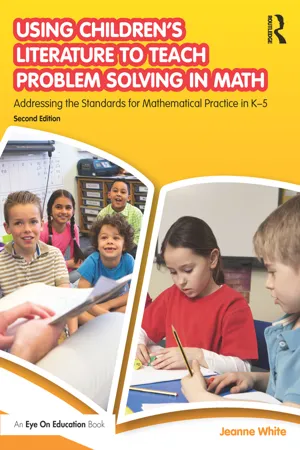
Using Children's Literature to Teach Problem Solving in Math
Addressing the Standards for Mathematical Practice in K–5
- 172 pages
- English
- ePUB (mobile friendly)
- Available on iOS & Android
Using Children's Literature to Teach Problem Solving in Math
Addressing the Standards for Mathematical Practice in K–5
About this book
Learn how children's literature can help K–5 students see the real-life applications of mathematical concepts. This user-friendly book shows how to use stories to engage students in building critical reasoning, abstract thinking, and communication skills, all while helping students understand the relevance of math in their everyday lives. Each chapter is dedicated to one of the eight Standards for Mathematical Practice, and offers examples of children's literature that can be used to help students develop that practice.
You'll find out how to:
-
- Encourage students to persevere in solving mathematical problems and use multiple approaches to find the answer;
-
- Help students reason abstractly with the aid of concrete objects and visuals;
-
- Guide students in constructing arguments to explain their reasoning and engage in critical discussion with their peers;
-
- Teach students to recognize mathematical patterns and use them to solve problems efficiently;
-
- And more!
The book offers activities for beginners as well as for more advanced problem solvers. Each chapter also provides guidance for ELLs and students with special needs, so no matter your classroom environment, you'll be able to use these strategies to make math class more dynamic, engaging, and fun.
Frequently asked questions
- Essential is ideal for learners and professionals who enjoy exploring a wide range of subjects. Access the Essential Library with 800,000+ trusted titles and best-sellers across business, personal growth, and the humanities. Includes unlimited reading time and Standard Read Aloud voice.
- Complete: Perfect for advanced learners and researchers needing full, unrestricted access. Unlock 1.4M+ books across hundreds of subjects, including academic and specialized titles. The Complete Plan also includes advanced features like Premium Read Aloud and Research Assistant.
Please note we cannot support devices running on iOS 13 and Android 7 or earlier. Learn more about using the app.
Information
1
Make Sense and Persevere
What Does This Standard Mean for Grades K–2 Problem Solvers?
Seven Blind Mice by Ed Young
There were 7 blind mice who found a strange Something by their pond then ran back home. One of the mice, Red Mouse, went back to the pond the next day to touch the strange Something. While he was at the pond, how many mice were still at home?
“First, I have to think, can I explain the meaning of the problem in my own words? There are 7 mice. One mouse is at the pond. How many mice are still at home? Next, I have to analyze what is given, what is not given and my goal. I am given the total number of mice at the beginning of the problem, which is 7. I am given the number of mice that went to the pond, which is 1. I am not given the number of mice that are still home, which is my goal. I can use 7 counters to understand and solve the problem by acting it out. I will use 7 counters as the mice at home. I will move 1 of the counters to an oval, which will be the pond. Now I can count the mice that are still at home. There are 6 mice still at home.” (See Figure 1.1.)

“I’m not finished yet because I have to look back at my answer and ask myself, does this answer make sense? Well, if I started out with 7 mice and 1 mouse was taken away from the group, there would be 6 mice left because 6 is 1 less than 7. So my answer does make sense. Does anyone have another way, or strategy, to solve the problem?”
“Janet, let me see if I understand your strategy for solving the mouse problem. You drew 7 mice then you crossed 1 out because you said that would be the mouse at the pond. Then you counted the mice that were not crossed out and you also got 6 for your answer. Okay, I understand your strategy for solving the problem. Thank you, Janet.”
There were 8 little rabbits who found a carrot patch but the farmer chased them back to their home. One of the rabbits, Brown Rabbit, went back to the patch to dig out a carrot. While he was at the carrot patch, how many rabbits were still at home?
Table of contents
- Cover
- Half Title
- Title Page
- Copyright Page
- Table of Contents
- Acknowledgments
- About the Author
- Introduction: Addressing the Standards for Mathematical Practice in K–5
- 1 Make Sense and Persevere: SMP 1—Make Sense of Problems and Persevere in Solving Them
- 2 Reason Abstractly: SMP 2—Reason Abstractly and Quantitatively
- 3 Construct Arguments: SMP 3—Construct Viable Arguments and Critique the Reasoning of Others
- 4 Create a Model: SMP 4—Model with Mathematics
- 5 Use Mathematical Tools: SMP 5—Use Appropriate Tools Strategically
- 6 Attend to Precision: SMP 6—Attend to Precision
- 7 Look for Structure: SMP 7—Look for and Make Use of Structure
- 8 Apply Repeated Reasoning: SMP 8—Look for and Express Regularity in Repeated Reasoning
- Next Steps
- Appendix
- References